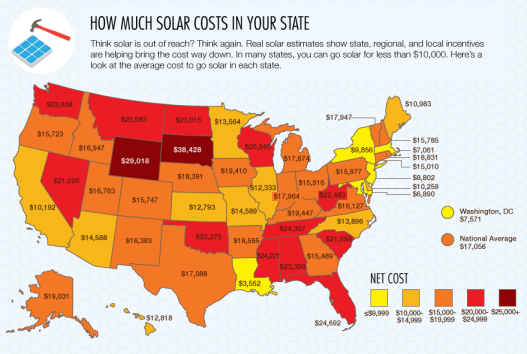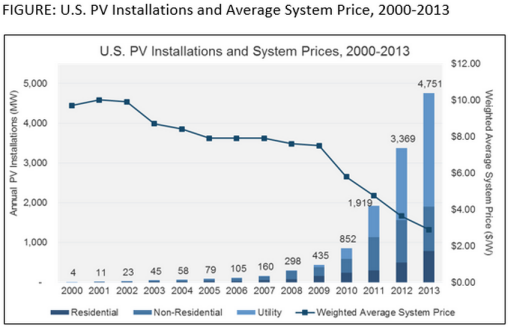Top Four Tips for Financing Your Solar Power System
Investing in a solar photovoltaic (PV) system can seem daunting. Let’s face it – solar PV isn’t a small ticket item. Most residential systems will end up costing you around ten thousand dollars or even more, depending on your electricity needs. Figure 1 shows that in 2011, the average cost of a residential solar PV system was approximately $17,000, but that costs ranged widely across the United States.
At first glance, these costs can seem off-putting and many consumers stop there. But the more financially savvy among us are digging a little big deeper to find that solar is a financially sound investment that is quickly becoming even more lucrative than ever before.
The truth is that the costs of solar PV systems have come down dramatically in the last few years and they’re continuing to plummet as technologies improve and the industry matures (see Figure 2 ). Today, consumers are saving hundreds or even thousands of dollars each year on solar, making the payback relatively quick and easy.
But the real cherry on top of the solar PV industry that sweetens the deal is the hundreds of different financial incentives offered by states and utility companies that are making solar PV more cost-accessible than ever. Here are a few quick tips for making the most of your solar investment.
- Rebates
– The first thing you should look for is how to bring down the
overall upfront cost of your solar PV system. Driven by public
policy goals to spur clean technology investments, states and
utility companies have been offering generous incentives for the
past few years to the tune of a few thousand dollars per system. To
see what incentives are available in your community, visit the
Database of State Incentives for
Renewables & Efficiency
(DSIRE).
- Financing
– Many states and utilities have also established low-interest
loan packages that help you spread out the costs of your investment
over time, often at an amount that is equal to or less than the
monthly savings you’ll realize through the investment. This means
that you can start to realize your return immediately by being
cash-neutral or even positive from the get-go. To find out what
financing options are available to you, visit your state’s energy
office’s or local utility company’s website.
- Solar
leasing
– Another option to consider is solar leasing, whereby you
don’t actually buy your solar array, but instead lease it from a
third-party company who installs it on your home and maintains it.
It’s essentially a different type of financing. The way it works
is you actually buy electricity from a solar leasing company,
typically at a lower rate than you would pay your utility company,
so you start seeing savings right away. Then at the end of the
leasing term, you typically will the option to own your solar PV
system so you can continue to reap the rewards without having to pay
anyone. Leasing terms vary by company, but typically companies offer
you no-money down options with loan periods that are around 10-15
years. Meanwhile, they pay for the maintenance of your system.
- Net
metering
– Net metering policies enable you to actually sell the
excess electricity produced by your solar PV system back to your
utility company. The way it works is that when your solar PV system
is producing more electricity than you’re consuming, the
electrical current actually goes back onto the grid and utility
companies give you an automatic bill credit at a rate equal to what
you typically pay them. In addition to offsetting your energy usage,
this means you can actually generate an income from your solar PV
system during peak-producing and low-usage times.
Some or all of these options are likely available in your area – incentives are popping up everywhere. The best way to find out what the best financing plan is for you, is to call your local solar contractor to get real cost estimates and details on available financing packages.
Recent Posts
-
Avoiding Hidden Dangers – Maintain Your Solar Panels Properly
Although solar energy is a sustainable power source, it doesn't mean your equipment will last f …13th Apr 2017 -
Beer, Courtesy Of The Sun...
Today is National Beer Day ( #NationalBeerDay ) and for many breweries across the world light …7th Apr 2017 -
Can Going Solar Help Your Business Succeed?
Businesses have faced many challenges in the years since the Great Recession, a stormy time of econo …8th Mar 2017


